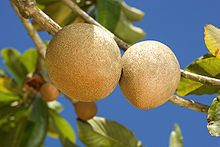One of the many customs of Rosh Hashana is to eat a "new fruit," meaning a fruit that has recently come into season that we have not had the opportunity to eat yet. For many years my parents would buy figs or dates. Other new fruits included star fruit, guava, papaya, persimmon, and pomegranate. So after we made kiddush (the traditional blessing over wine) and hamotzei (the traditional blessing over bread), my mom brought out the new fruits for 5771. We usually play a game and try and identify them. No one in the family, not even my dad who is a biology teacher succeeded. The first one looked like this:
Can you guess what it is? Give up? It's a Mamey, also known as a memey sapota. It is grown primarily in Mexico and other Central American countries. When ripe it's taste most resembles a combination of pumpkin, sweet potato, and maraschino cherries. Unfortunately for us, this mamey was not ripe. It was impossible to peel and slice. When I bit into it, it was chalky and tasted like bathroom spray.
The second fruit looked like this:
Any idea what this one is? It's a quince. A quince is a relative of the apple and pear and mainly found in Asia and the Mediterranean. Unbeknownst to us, a quince is not eaten raw because of it high tannin content. It's best used in jams, jellies, and preserves.
I give the Paramus Fairway Market for showcasing exotic fruits that can be used as new fruits for Rosh Hashana. However, I also blame them for this year's new fruit fail. If you're going to showcase exotic fruits that most of have never seen, it would have been nice to include some signage about how to pick a ripe mamey or let us know that the quince should not be eaten raw.


No comments:
Post a Comment